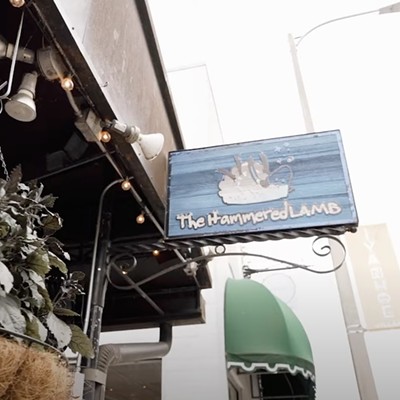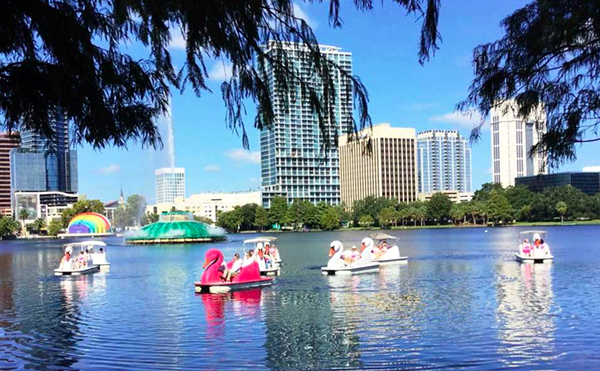Central Florida fairly floats. From expansive lakes to mighty rivers to the miles of beaches on both coasts, there is literally water, water everywhere. Staying dry during summers in Central Florida is not only impossible; it's ill-advised.
However, being creatures of habits, we often stick with what we know. Water-skiing on Lake Ivanhoe, beaching it at New Smyrna (if you're a native), Cocoa (if you're a transplant) or Daytona (if you're a masochist). These are the places where Central Floridians end up when their thoughts turn to water.
Yet this area is one of the richest in the country in a variety of water-based recreational activities. It can be daunting, though, for mere weekend warriors to find the diamonds in the rough.
So we contacted a group of local naturist experts to get the skinny on the wettest places for sun and fun in Central Florida.
Their advice:
Trailing with the;Association
Judy Minter, of the Florida Trail Association, describes her organization as a recreational group with a political agenda. Organizing events for its members in hiking, canoeing and biking, the Florida Trail Association has a number of water-based recommendations for adventurous Central Floridians.
Covering Orange, Seminole, Osceola and Lake counties, the local chapter of the association also lobbies state and local governments on conservancy issues and takes responsibility for cutting and maintaining miles of hiking trails across the area.
But the association is primarily concerned with hooking up its members with some of the state's most beautiful trails and outdoor options. Indeed, Minter says Florida is particularly rich in them.
"There really is a lot of great canoeing in Central Florida," she says, emphasizing a number of places nearby. "Econ River at Hidden River Park is a great canoeing run. It isn't terribly accessible, however." With access only from Highway 50, east of Alafaya Trail, and at State Road 419 in Oviedo, the canoe landings can be difficult to find.
Minter also recommends Blue Springs near Deltona, Rainbow River near Dunedin, Juniper Springs in the Ocala National Forest and the Tomoka River Canoe Trail near Ormond Beach for that favorite pastime known as tubing. For kayaking enthusiasts, she recommends New Smyrna's Mosquito Lagoon.
One of the Florida sites about which Minter hears the biggest buzz is Caya Cota, an island off Bocelia in the Gulf of Mexico and near Punta Gorda. A ferry is required to reach the campgrounds.
"I haven't been in a couple of years, but it was beautiful then," she says. "And everyone I know who has been recently still raves about it."
But if you're at all apprehensive about navigating the state's waters in an inner tube or kayak, Minter advises not to worry.
"I know for myself, and for everyone I've spoken to, there isn't much to worry about. You will get wet, no doubt about that. But the skill level required is minimal," she says.
Wilderness Trekkers: ;Investigating Florida's;Interior Treasures
Wilderness Trekkers is a three-year-old organization boasting more than 400 members. The group organizes day and overnight backpacking trips through mid-Florida.
"For all skill levels and in all areas of Central Florida, there are places to explore wilderness and to make the most of the natural bodies of water in the area," says Wilderness Trekker Lynn VanHorne.
A favorite of the group is tubing at the Santa Fe and Ichnetucknee Canoe & Camp. Located in northern Central Florida, the winding Ichnetucknee River is one of the most scenic and pristine of the area's rivers. And like most of Florida's best tubing and canoeing sites, the river is appropriate for all ages and skill levels.
"Tubing is often the most popular activity on the Florida rivers because, due to the flat topography of the state, speeds never exceed just a few miles an hour," says VanHorne; thus, riders can comfortably navigate the flow without risk of injury.
Canoeing also is popular at places such as DeLeon Springs and Blue Springs, both near DeLand. But for those wishing for something a little closer to home, Seminole County is home of one of the most active springs and canoeing sites: Kelly Park, north of Apopka on the west side of the Wekiva River Basin, offers excellent canoeing, swimming and tubing. VanHorne does have a warning, however.
"The park fills up fast," she says. "Particularly this time of year, there's a line of cars by early in the morning. You might need to go very early to find parking and a place to put your gear."
Accessible either by following signs from downtown Apopka or from State Road 46 near Plymouth, Kelly Park's popularity can also be traced to the safety of the waterway.
"The water never gets deeper at most points than three feet. That makes it safe for all but the youngest of kids," VanHorne says. In particular, the Rock Springs Run is considered one of the best canoe runs in Florida. "Excellent for beginners," she adds.
The swimming is also outstanding. "You really can't -- or shouldn't -- swim in most lakes in Florida, and the springs are such a nice alternative. They're always cool, and [with] fewer carnivores to worry about," she says.
Although generally accepted as a much more rigorous activity, scuba diving requires expensive equipment and certifications. For those who are willing, however, Central Florida's Blue, Alexander and DeLeon Springs all have outstanding amenities: clear water, a broad mix of flora and fauna and easy accessibility to metro Orlando.
Watching and Waiting: ;Orange Audubon Society
For the less physically adventurous, Orange Audubon Society is a must-do for bird-watchers and nature lovers alike. Affiliated with the National Audubon Society, Orange Audubon is one of four Florida chapters. Activists for conservation, growth management and protection of imperiled wetlands, Orange Audubon is 1,600 members strong.
Tom Williams, president of the Orange society, champions a wide variety of birdwatching opportunities on Florida waterways. One that is perhaps the most improbable is also William's favorite: The Orlando Wetlands Park, located in east Orange County behind Fort Christmas, is adjacent to the Iron Bridge wastewater treatment plant. On 1,200 acres, the filtered effluent from the treatment plant fills the wetland; as a result, there are excellent opportunities for watching birds, who are attracted to the site by the marshy land.
"Most of the aquatic birds of Florida are there, although I'd say that waterfowl like ducks and geese have fallen off a bit," Williams says.
Other promising vistas include Merritt Island National Wildlife Preserve in Titusville, which boasts many wading and aquatic birds, and Esmerelda Marsh on the eastern shore of Lake Griffin in Lake County.
For the natural-water enthusiasts, Williams recommends the St. John's Water Management District, the "Recreational Guide to District Land, " which summarizes recreational activities.
And with hundreds of entries, it makes clear just how much the state -- and Central Florida in particular - has to offer the outdoor adventurer.
Orange Audubon Society, Tom Williams, president, 332-5089
St. Johns Water Management District, Librarian's Office, (904) 329-4123
The Sierra Club, Mary Slater Lynn, 894-4530, http://www.sierraclub.com
Wilderness Trekkers, Lynn VanHorne, 331-8609, [email protected]
Florida Trail Association, Judy Minter, public relations coordinator, 365-1080, http://www.atlantic.net/~fta/
















